Laying vinyl floor tiles
Choosing flooring is a tricky task. It should be reliable, durable, beautiful, non-slip, durable. It is also desirable that it fits easily. All these conditions are met by PVC floor tiles.
The content of the article
What is PVC (vinyl) floor tiles
Not so long ago, another type of PVC coating appeared on the market - vinyl tiles. It is somewhat similar to good linoleum (hence another name - linoleum), but the production technology is different, as is the release form. This material is cut into rectangles or squares, can be glued or not. It has more than one name - LVT tiles (LVT) - an abbreviation of the English name Luxury Vinyl Tile. Design or art tiles - this is also understandable - designer floor coverings are created from squares or rectangles.
The release form turned out to be so convenient that it quickly conquers the market. It is easier to fit, more economical. Not in terms of price - it’s just high (at the level of commercial linoleum), but in the sense that there is a minimum of scraps - much less than when using linoleum. This, and its excellent performance, is the secret of its growing popularity.
PVC floor tiles consist of vinyl and resin, to which stabilizers, plasticizers, and sometimes fillers are added (to give specific properties or a special appearance). The heated mixture is pressed. The resulting material has a high density, but remains flexible and ductile.
PVC tiles consist of several layers:
- Two base layers.
- Film with a picture.
- Transparent PVC protective layer.
- Wear-resistant polyurethane layer.
In terms of composition, there are two types of linoleum tiles: vinyl and quartz vinyl (vinyl quartz). The second option is more expensive, but also more dense, with increased wear resistance.
Types and varieties
According to the method of installation, there is a PVC tile for the floor on a self-adhesive basis, there is a usual one (for the installation of the second type, glue is required). This type of flooring material is glued end-to-end on a flat, clean base. With this installation method, the floor covering forms a monolith with the base.
There are tiles with locks - mechanical and adhesive. The elements are connected to each other using these locks, and the coating itself turns out to be unconnected with the base. This option is called "floating" floor.
Like linoleum, PVC floor tiles are classified according to the degree of load:
- Class 23-31 is suitable for rooms with a small number of visitors. It can also be called household. Linoleum tiles of this class are the cheapest, have a thickness of up to 2 mm and a not very thick protective layer. Furniture on wheels should not be used on such a surface.
- PVC floor tiles of class 32-42 are intended for rooms with intensive use. Its thickness is from 2 mm to 2.5 mm, the thickness of the protective layer is sufficient to withstand any furniture, including those on castors. This class is optimal for apartments and private houses, and the thickness of the protective layer should be from 0.3 mm (more is better, but also more expensive).
- Class 43 is a super abrasion resistant coating that can withstand even transport. Scope - workshops and production facilities.
In any of the classes, the choice of colors and textures is very wide.There is an imitation of natural materials - wood, various types of stone, etc., there are monophonic ones, with or without decorative additives. Most often there is a rectangular shape, with different side lengths, there are squares. Rectangles are most often made "under a tree", imitate parquet or wooden floor, but the squares are more often monochromatic. Interesting panels are collected from them.
When choosing, simultaneously with the class, one must look at the thickness of the protective coating. The thicker it is, the more durable the coating will be. The optimal choice for a house and an apartment is a tile thickness of 3 mm, a protective layer thickness of 0.3 mm.
Pros and cons
We have collected the main properties of vinyl floor tiles from the reviews of the owners (and hostesses) of such a floor covering. She had a lot of advantages:
- Easy installation. PVC tiles for any type of floor are easy to install, even those that are glued. During installation, there is no need to take out all the furniture from the room, as when laying linoleum. You can move it one half, then transfer everything to the already laid one.
- High coating strength. Out of 10 reviews, only one said that small cracks appeared on the surface (when the refrigerator was brought in and in the place where the dining table is).
- Tightness and ease of care. Do not be afraid that water has spilled - if laid correctly, the flooring is hermetically sealed. You can wash it by any means. The only thing that was noted was that the relief tiles (which not only imitate the pattern of the tree, but also its texture) should be washed along the relief. Otherwise, dust gets clogged into the grooves. But at the same time it was noted that caring for PVC floor tiles is much easier than for laminate and linoleum (dust "sticks" less).
- Nice to walk. Vinyl floor tiles are non-slip even when wet. Even in the cold season, it feels "warm". She was placed in the bath instead of ceramic tiles. The base was the same, but the sensations are much more pleasant.
- She is "quiet". PVC tiles for the floor are laid without a backing - directly on the base, but at the same time it has good sound insulating properties. It is not echoing, it is cozy in a room with such flooring, and the neighbors below do not complain.
- When sharp and heavy objects fall, no marks remain (quartz vinyl tiles).
In general, almost everyone unanimously declares that PVC floor tiles are the best they have had so far. Moreover, “before” there was laminate, linoleum, ceramic tiles, some even had parquet. Disadvantages were also collected from reviews. There were not so many of them:
- The coating is new, so it is not clear how it will behave in the long term. The oldest review is 5 years of operation.
- Quartz vinyl tiles with a good protective coating cost a lot.
- The coverage is still unnatural.
As you can see, this is a really good option. Suitable for any premises - technical, residential, with difficult operating conditions.
Styling
The actual laying of vinyl tiles is not a very difficult process, but it requires precision. Pay special attention to the laying of the first two rows, on which all the rest then rest. There is also a difference in the technique of gluing vinyl tiles on glue, laying self-adhesive or with locks. But there are general requirements as well. Let's consider all the questions in more detail.
What tools are needed
You will need a decent set of tools to work, but they are all inexpensive, many are on the farm. So, you will need:
- Steel meter ruler. Glue several pieces of double-sided tape to it from the back. It is necessary so that she "does not go". And so that the tape is not very sticky, sprinkle it with dust, gis, etc.
- Stationery knife with replaceable blade. The knife should be good and comfortable, the blade holders are better steel, the blades themselves should be strong and sharp.
- If you have chosen linoleum floor tiles to be glued, you need a notched trowel with a fine tooth.A tool for laying ceramic tiles will not work - the "tooth" should be triangular and a few millimeters high. If you don't find this, buy a regular one, use a file on the blade to make the necessary cuts - 1-2 mm.
- Roulette.
- Wide paper tape - 5 cm, several rolls. It is needed if the vinyl tile will be glued.
- Lapping block - a wooden block upholstered with felt, carpet, two or three layers of rigid fabric.
It would also be nice to have a hair dryer. In difficult places - when bypassing pipes - it is more convenient to cut the tile when it is heated. Then it's no more difficult than cutting household linoleum. And you can only warm it up with a construction hairdryer. Cut the heated tile, wrap it around the pipe, cut off the excess.
How to cut PVC tiles
Although the linoleum tile is dense, it is easy to cut in a straight line. If you want a cut that won't fit the edge of the tile, it's easier to work. Pass the blade with effort along the front side, bend it at the place of the cut, cut the rest with a knife along the fold line.
If the cut needs to be straight - for joining with the next tile, you will need a ruler on tape - so that it does not move. In this case, you will have to cut through everything from the front side. This cannot be done at once, but since the ruler will not move, it will be possible to use the blade two or three times.
Foundation preparation
You can install vinyl tiles yourself. It is only important that the base is properly prepared. It should be flat, clean, dry and tough. PVC floor tiles can be laid on concrete, screed of any type, plywood, fiberboard, OBP, GVL and other similar materials.
There is one nuance with concrete floor and screed. The DSP screed is too loose and not rigid enough. It is better to level it under vinyl tiles with a gypsum-based self-leveling mixture. It's easy and not very expensive, but the result will be great.
When laying vinyl tiles on a wooden floor, it is leveled with plywood 12-15 mm thick. You can use GVL or OSB. All fasteners must be recessed and the holes filled. They also putty the joints between the sheets (do not forget to lay the plates apart and leave seams of 2-3 mm to compensate for thermal expansion). To putty joints, it is better to use acrylic putty - it is more elastic and smoother, adhesive tiles hold better on it. In general, it is better to lay on wooden floors not glue tiles, but floating ones - with any type of locks (mechanical or glue). There is less chance that the coating will bulge somewhere due to the difference in the amount of thermal expansion.
The last stage in preparing the base is impregnation with a suitable soil. The base will become even stronger, the absorbency will decrease and even out, and the consumption of glue will decrease.
It is also very important that the base is dry. Its moisture content should not exceed 5%. They measure it using a special device, but there is none in the household. So you have to get by with the means at hand. We take a piece of polyethylene without holes and masking tape. Tightly glue the polyethylene with tape to the base (along the edge in several layers) and leave it for a day. After a day, peel it off and feel it from the inside. If there is no condensation, everything is fine - the floor is dry enough to start laying PVC tiles.
Laying methods and marking
If the installation of PVC tiles is done by hand and you use "planks" that imitate wood, there is no experience with such material, it is better to start with the simplest scheme - with an offset. For this method of laying, it is better if the offset is arbitrary - no joints are visible. When using this scheme, it is only important that the joints of the "boards" are spaced at least 15 cm apart. This method of laying is also economical - a cut piece from the last element in a row can serve as a starting plate in the next one (or after one, if the joint is closer than 15 cm). Other common offset options are 1/3 and 1/2 of the board length. In this case, the pattern is more regular and the joints stand out more.
With this method of layout, the planks are usually placed along the long wall of the room. When using lockless PVC tiles, the layout starts from the middle. To determine the location of the starting strip, find the middle of the room. Then a line is drawn through it, parallel to the walls. This is done with a paint cord or ruler and pencil. This line is guided by when laying the first two rows of vinyl tiles, aligning the edges of the tiles with it. With other layouts, everything is more complicated - you have to calculate, draw, and this is not so simple.
Vinyl Tile Adhesive
Special glue is used - for gluing PVC coatings. There are two types of compounds: glue and fixation. Everyone knows what glue is, but few know about fixations. This composition differs in that it does not dry out to a solid state. When it dries, a sticky substance remains on the surface, similar to the one found on scotch tape. This method is good because the glued coating can be peeled off several times. In this, it is also similar to the sticky composition of scotch tape. The PVC tile is peeled off for fixing without difficulty, and even after a solid period (several years or tens of years). At the same time, it will not be possible to move the cover that has been set on fixation: lateral displacements are excluded. It comes off only if you pull the edge of the tile up.
It doesn't matter which type of adhesive you choose. It is important that it is suitable for gluing PVC coatings, and not expired.
Laying PVC tiles on glue
Apply the adhesive in an even layer on a dry and clean substrate along the strip marked on the floor. The width of the strip of glue is for laying two tiles, if they are long and narrow, the length is to the end of the room. When applying the glue, spread it with a fine-toothed spatula. There should be no bald spots or puddles. It is necessary to achieve an even distribution. If, according to the instructions for the glue, it must be given time to dry - we are waiting. If not, you can put it right away.
We put the first row aligning one edge strictly along the drawn line. When applying glue, try not to grease it, otherwise you can lay it crooked. We laid the first tile, ironed it with our hands, expelling the air from under the material. We step on the laid tile, put the next one, tightly fitting the joint. We glue a piece of masking tape about 10 cm long to the newly laid board. Glue about half of the tile to be laid, pull it tightly to the laid one and fix the tape. This way the tile has no chance to move. Having fixed it, we iron it, expelling the air. We repeat with the next one. When laying the second row, we also fix it from the sides using 3 strips of adhesive tape.
Having laid two rows, we take a pressure bar and rub the laid coating well with it. This is how we expel the air completely. According to the technology, it is necessary to use a pressure roller weighing 50 kg, with which the freshly laid coating is rolled. At home, it is not, you have to replace it. There is another way to glue linoleum tiles well: after laying, it is good to tap it with a rubber mallet.
Next, two rows are laid on the other side of the strip. After the installation order is no longer so important, it is very desirable to remove air in one of the ways.
Why do you need tape fixation, because it is rarely used? So that the already laid tiles do not move, and this is possible, since the time for complete drying of the glue is 72 hours.
Self-adhesive
Self-adhesive PVC floor tiles are installed as well. The difference is that you don't need to apply glue.Before installing the tiles, remove the protective layer, lay the tiles in place, smooth them down. The rest of the procedure is the same.
In this case, the strips do not need to be fixed with tape, since the substance on the wrong side is sticky enough to keep the coating from shifting immediately after gluing. An important nuance - you must first press the tiles to the side surface, keeping the plank in weight. When the edge is joined, the coating is gradually lowered, trying to leave as little air as possible.
Laying PVC tiles with a lock
The lock on vinyl tiles can be mechanical and adhesive. The only difference is in the principle of fixation. The rest of the rules are the same.
The main difference is that the laying of interlocking vinyl tiles starts from the wall. The planks are positioned so that the locks "look" into the room. The first row is laid stepping back from the wall a few millimeters - to compensate for thermal expansion. This gap can be achieved by installing pieces of material of suitable thickness or by finding thick crosses for the tiles.
When laying PVC tiles with a glue lock, you must first join the end, aligning the edges of the boards. Then the lock is joined along the long side and, only after that, the slats are completely lowered. The edges are ironed, checking the tightness of the occurrence of the mechanical lock.
The following video demonstrates how PVC tiles are laid on a floor with a mechanical lock. Usually the material comes with instructions with pictures, but watching the video is also useful.
The installation process for self-adhesive vinyl tiles is shown in this video. The connection is equally reliable and the assembly of the cover is even easier.

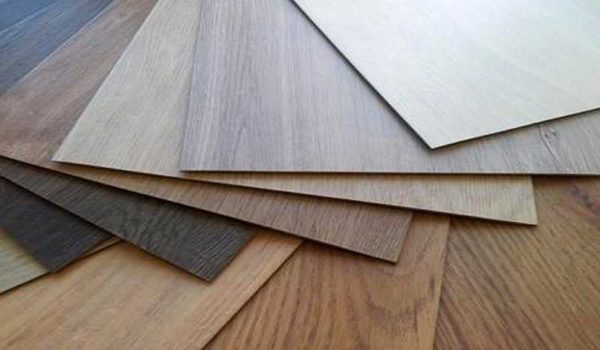


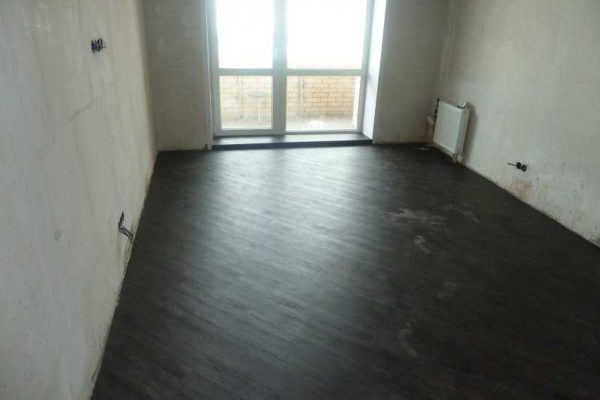
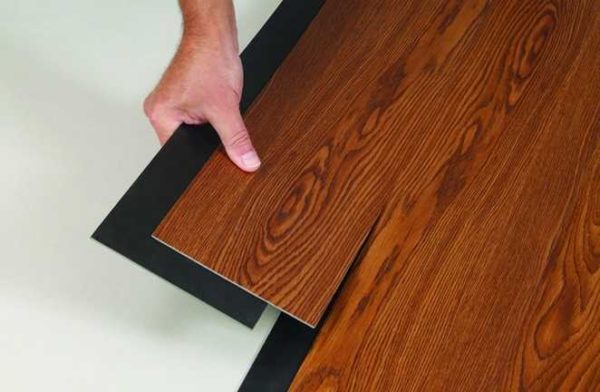
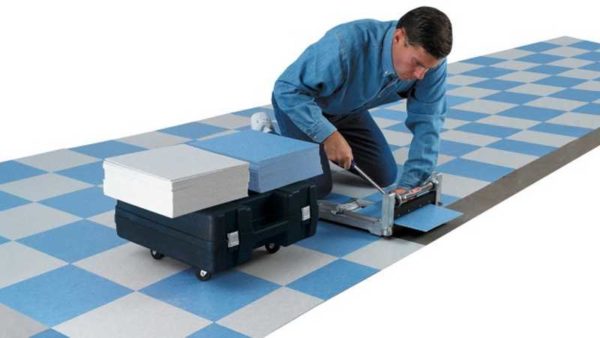
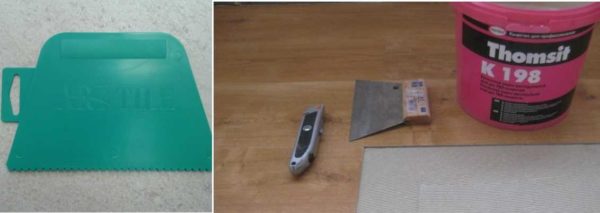
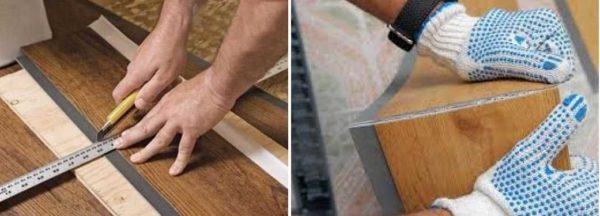
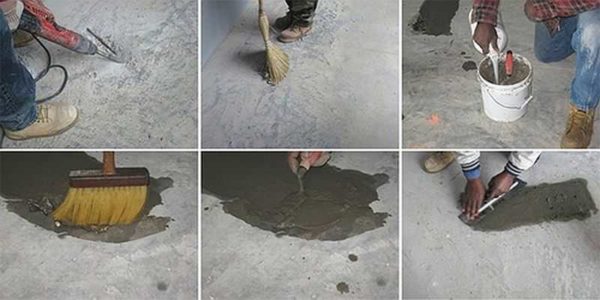
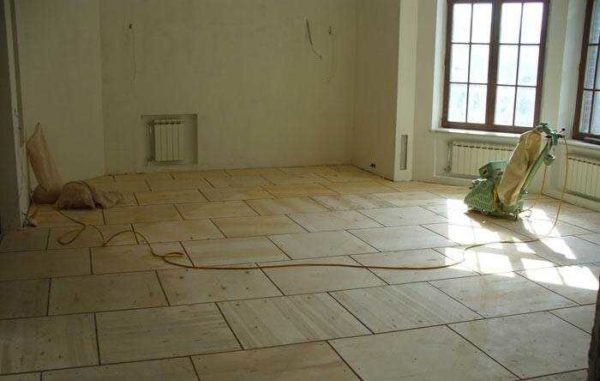
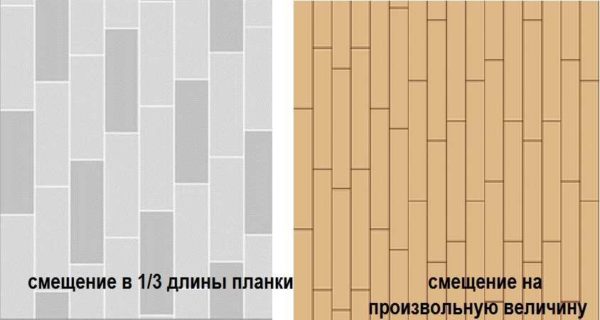
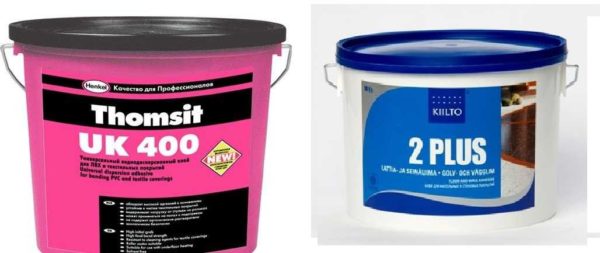
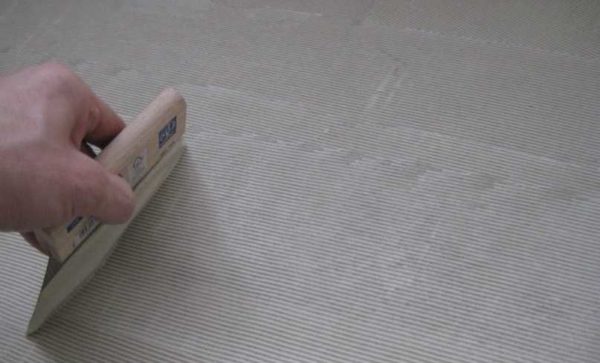
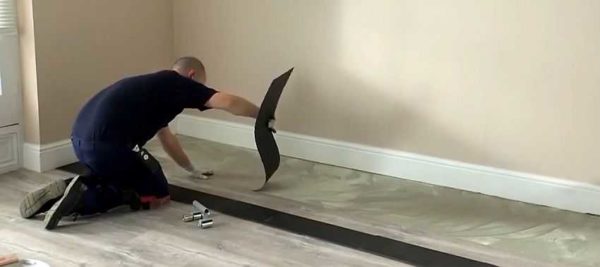
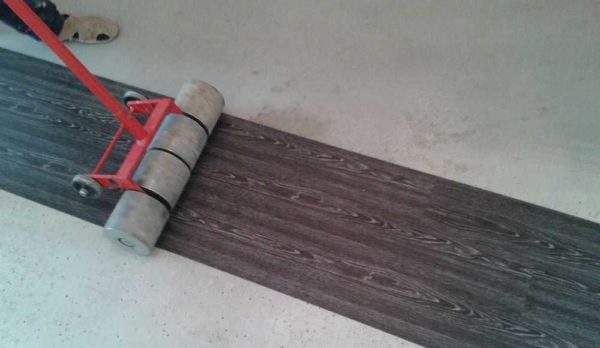
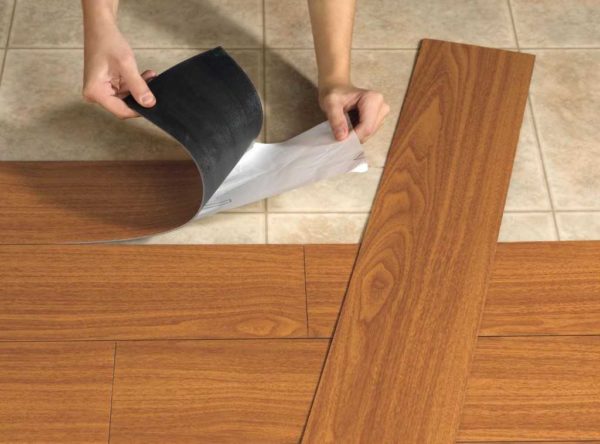
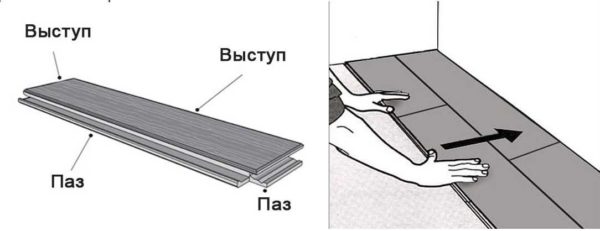

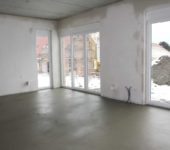
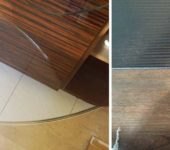
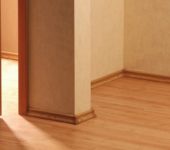
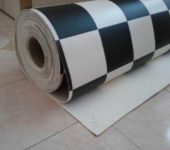





but how to cut a square tile?)
Cutting square vinyl tiles in the same way as cutting long ones. Make an incision along the face with a sharp blade, bend so that the face comes apart, then cut the base.
Is it possible to put planks with a lock on linoleum, which in turn lies on chipboard slabs? Smooth linoleum.
You did not specify what kind of linoleum is laid and whether it is planned to be installed on top of relatively heavy furniture. If dents from furniture remain on the linoleum, then this is not the best foundation. We still need to look at the recommendations of a particular manufacturer. Some indicate (for example, Tarkett) that laying on linoleum is prohibited, others allow laying on almost any old coating, provided that it is relatively even (unevenness up to 3-4 mm). It is better to look into a specialty store and ask a sales assistant to show you the options for vinyl tiles for laying on linoleum.
In the premises of the assembly workshop, ordinary tiles are laid. Can you lay your tiles on top of ceramic tiles to insulate the floor? Workers enter and leave the premises, snow sticks to the sole in winter - and linoleum is very slippery in this case.
A car service requires a special tile. Modular PVC floor covering Unipol Grain 7 mm is suitable, withstands a static load of 30 tons per square meter. Has an anti-slip effect.
In general, there are many different coatings for car services and garages: Rice, Gutta, Coin, Yuzipol, Sensor, BronePlast, etc.
Please tell me if there are any contraindications for use on a warm water floor?
With a water-heated floor, only the temperature is limited - the heating should not exceed +28 degrees Celsius.
Hello! We want to lay tiles in the kitchen, the base is plywood. The temperature regime ranges from 18 to 26 degrees at different times of the year. Can adhesive tiles be laid? Will it warp?
Subfloor assessment can only be verified on site. Those. you need to invite a knowledgeable person who can check the basis for suitability.
And yet - which tooth is preferable with a spatula? Spatula for Biber 35271 glue teeth type S2-S4, B3, D6?
Follow the instructions for the glue. For example, here's an excerpt for Arlok 33:
"The size of the notches of the trowel depends on the evenness of the surface and the base of the coating: for a smooth base (vinyl coverings) use a notched trowel A2, for structured (textile coverings) - B1."
Good day! Can you put such tiles in the bathroom?
Can. On an even screed without problems
can this tile be laid on parquet? the parquet is even without drops
Parquet floor changes its dimensions even under a layer of varnish. Old parquet simply cannot be a good foundation. Lushe don't risk it and take it off.
Better to repair the parquet. Why cover a chic parquet with something.
Hello!
how to lay or glue vinyl tiles on ordinary tiles (porcelain stoneware) with slight differences. How to level (not expensive) the floor, then to glue the tiles
Isn't it easier to beat off the porcelain stoneware with a perforator and fill the self-leveling floor?
Is it possible to lay tiles on linoleum, the floor is even without drops
In my opinion, this is not the best idea. The fact is that linoleum is much softer than vinyl tiles. According to the instructions, the base for vinyl tiles should be not only even, but also strong. It is unlikely that linoleum can be attributed to solid foundations.
Good afternoon, can you put such a tile on the floor in a shower with a ladder?